Panasonic Lumix DMC-FZ18
-
-
Written by Gordon Laing
Panasonic Lumix DMC-FZ18 design and build quality
The Panasonic Lumix FZ18 shares the DSLR styling of its predecessor the FZ8, and despite being a few mm larger in every dimension, is still much smaller than it looks. In the photo below we’ve placed it alongside Fujifilm’s FinePix S8000fd and Canon’s ESO 400D / XTi, and it’s clear both super-zooms are dwarfed by the genuine DSLR.
 |
The grip is obviously a scaled-down version of what you’d find on a real DSLR, or even most other super-zooms, but with it and the newly rubber-coated ridge for your thumb on the rear, it’s possible to hold the FZ18 quite securely – and many will also find it easier to hold with one hand than one of Panasonic’s compacts, like, say, the FX33. If you have large hands though, we’d advise picking it up in person, as it may be a little too small to hold comfortably.
It’s interesting to compare the FZ18 against the company’s metal-bodied compacts though as the latter feel much more substantial, while the FZ18 can come across as quite plasticky in comparison. Despite gaining 50g over its predecessor, the FZ18 is also much lighter than you’d imagine, but while it doesn’t feel as solid as Panasonic’s metal compacts, the overall build quality remains to a high standard. The materials and joins are smooth, well-assembled and there’s certainly no creaks to worry about.
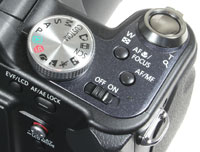 |
At first glance the FZ18’s controls appear the same as its predecessor, but look a little closer and you’ll notice several differences. Starting on the upper surface, the command dial has had a make-over with 14 positions to its predecessor’s ten. The Program, Manual, Aperture and Shutter Priority modes remain as do the Movie, Print, Play and SCN positions, but both the fully automatic heart and Intelligent ISO modes are gone, the former now hidden in a menu.
In their place are Panasonic’s new Intelligent Auto mode, a Custom option which allows you to program three different selections of options, and direct access to the four most popular scene presets, Portrait, Landscape, Sports and Night Portrait. We’ll explain these in more detail in our Features pages.
As before, the shutter release button is housed within a circular zoom rocker, but the optical stabilisation button of the earlier FZ8 has been relocated into the on-screen function menu, and the single ‘AF / macro / MF’ button replaced by two which switch between Macro and normal AF, and auto or manual focus modes. The power switch has also been relocated to this upper surface.
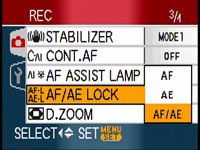 |
Turning to the rear surface, the popup flash is still manually opened by a button at the top left corner, and there’s a button for switching between the electronic viewfinder and main LCD monitor. The space where the old power switch used to lie is now occupied by a new AF / AE lock button which can be configured in the menus to lock either focus or exposure, or both.
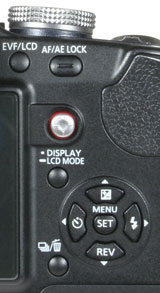 |
The rest of the controls remain the same as its predecessor and are concentrated in the lower right corner on the back of the camera. Like most Panasonic models, four buttons arranged like a joypad are used to navigate menu options, scroll across images during magnified playback, or select various options during shooting. A button in the middle of the four brings up the main menu system or confirms settings.
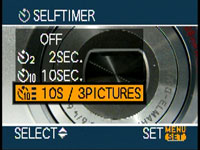 |
Pressing the top of the four buttons while shooting presents the exposure compensation settings, offering the traditional +/-2EV range for darkening or brightening exposures. Pressing the bottom button shows the last image taken (or viewed during playback), and like playback mode, you can magnify using the zoom lever.
Pressing the left button lets you choose between a 10 or two second self-timer, along with a neat option which after a 10 second countdown takes three photos at two second intervals just to make sure.
Pressing the right button cycles through the options for the built-in flash once it’s been manually popped-up: Auto, Auto with red-eye reduction, Forced on (with optional red-eye reduction if you’re using the Party or Candle Light scene presets), and Slow sync with red-eye reduction. If you don’t want the flash to fire, simply don’t pop it up.
Two further buttons to the left of this main group switch the display mode and either delete images or adjust the continuous shooting options. Most important of all though is a small joystick just by the top right corner of the screen. Pushing this in presents the FZ18’s excellent dropdown menu system which gives you very quick and easy access to a wide variety of settings including ISO, White Balance, image quality, and now also the optical stabilisation options. Like its predecessor and other Panasonic compacts, it’s one of the best user interfaces around and we’ll explain how it works in our Features pages – we also have a demonstration in our FZ18 video tour.
Panasonic Lumix DMC-FZ18 connectivity and battery
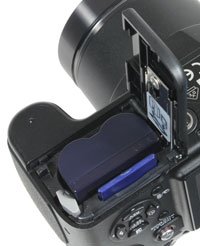 |
A door on the left side of the FZ18’s body opens to reveal DC-in and a combined USB / video out port; the DC-in port works with the optional DMW-AC7PP AC adapter. A larger door under the grip side of the body houses the battery and SD memory card slot. Like its predecessor, this door is blocked when the camera’s mounted on a tripod.
The Lumix FZ18 is powered by the same CGR-S006E 710mAh Lithium Ion battery pack as its predecessor and the camera is supplied with a mains recharger. Panasonic claims the same number of shots per charge as its predecessor: 380 shots under CIPA conditions, but that’s a best-case scenario. If you end up composing mostly with the screen and with optical stabilisation activated, you may get closer to half this number, so investing in a spare would be advisable.




